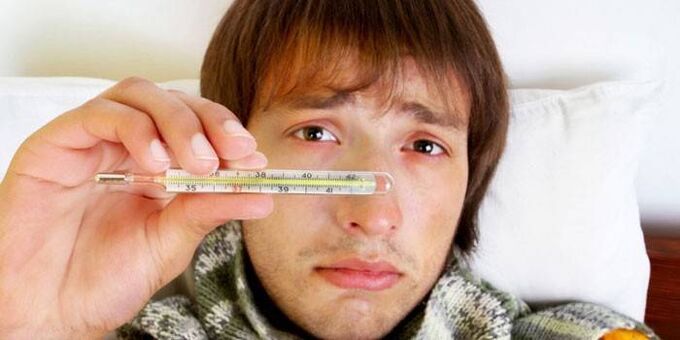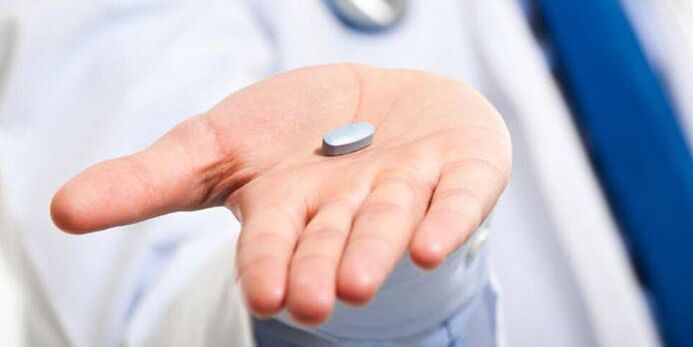Every second man of reproductive age (up to fifty years) is prone to subtle diseases such as acute prostatitis, in which, under the influence of certain factors, the prostate (prostate gland) becomes inflamed, causing various forms of sexual disorders. function, fertility, and psycho-emotional state. Be careful what your body says, and don’t neglect timely treatment.
Is acute prostatitis
If a man feels uncomfortable and even sick during urination, you should immediately see a doctor, because acute prostatitis is an infectious etiological disease that causes inflammation of the prostate, followed by the formation of edema of glandular tissue, the formation of purulent foci. on it. If you do not pay attention to the signs of acute inflammation of the prostate, then the pathological process can turn into a chronic form that is difficult to treat, and there is little time for reflection - the transformation occurs in a few days.
However, more serious complications are possible from its transition to the chronic form. There is a risk of sepsis - a general infection of the blood and an ascending infection of the urinary tract with the development of pyelonephritis and cystitis. In this case, the patient is admitted to the hospital immediately, his condition may be critical. Although sepsis as a complication is rare, it can occur in patients in immunosuppressive conditions - intoxication, fever, severe symptoms, weakness. Therefore, blood cultures are required to detect microorganisms.
Symptoms of acute prostatitis
Every man needs to know and remember the symptoms of acute prostatitis. Common signs of this disease are shown:
- Sharp pain when urinating.
- Drunk body.
- Disorders of urination (intermittent, weak, tense stream).
- Frequency of desire to visit the toilet at night.
This is an external symptom of prostatitis, but with more in -depth study, leukocytes, traces of mucus and pus in the secretory fluid of the prostate gland are found in the urine. On palpation, a dense and enlarged organ is felt, pressing will be painful. The further development of the inflammatory process is characterized by heaviness and pain in the perineum, radiating to the penis, sacrum and rectum. As a result, the patient becomes difficult to empty the bladder and defecate due to severe pain. Body temperature can rise up to 38 ° C.

Causes of acute prostatitis
Because the disease is a bacterial inflammation, the following infectious agents are the cause of acute prostatitis:
- Gram -negative - Klebsiella, E. coli, Proteus.
- Gram -positive - enterococci, staphylococci, streptococci.
- Urogenital - trichomoniasis, chlamydia, ureaplasmosis, gonorrhea, candidiasis, mycoplasmosis.
The microbial microflora penetrates into the tissues of the prostate gland, as a rule, through the transcanalicular route (through the urethra and the excretory tract of the prostate gland). In cystitis, the infection migrates to the prostate from the bladder. Other possible pathways for bacterial penetration are opened during endourethral manipulation (catheter placement, urethral bougienage, cystoscopy, urethroscopy). Pathogenic microorganisms migrate into the prostate from distant pathogenic foci in caries, sinusitis, tonsillitis, cholecystitis, pyoderma, bronchitis.
There is a high probability of infection of the intestine with proctitis, hemorrhoidal fissures, colitis. Non -infectious factors that can cause an attack of prostatitis are the phenomenon of congestive veins (congestive) in the pelvic area and the acini drainage of the affected glands. Congestion can be caused by irregular sexual activity or, conversely, excessive sexual activity, sexual dysfunction, inactive lifestyle, frequent constipation, frequent alcohol intoxication, small pelvic varicose veins, hypothermia.
Acute forms of prostatitis
The clinical development of the disease is considered in three stages, which at the same time are a form of acute pancreatitis. This is:
- The first stage is the catarrhal form.
- The second stage is the shape of the follicle.
- The third stage is the parenchymal form.
Acute prostatitis in men begins with catarrhal inflammation, which is characterized by the expansion of the acini, the occurrence of edema of glandular tissue and, consequently, an increase in organ size. The excretory ducts of the prostate gland, which open into the posterior urethra, are actively involved in the inflammatory process. The lobes and ducts of the prostate gland become inflamed, their contractions are disrupted, they are narrow and clogged, this can make it difficult to secrete prostate secretions.
At the catarrhal stage, the pathological process stops at the mucous layer and does not go deeper. In the process of development, the disease spreads throughout the prostate gland. Acute follicular bacterial prostatitis develops. On analysis in the urine pus begins to reveal. Glandular tissue changes destructively, swelling continues to increase. The follicle shape can still receive relatively simple treatment.
Further, the parenchymal form of the disease develops, the result of which can be a prostate abscess, which is chronic prostatitis. Therefore, symptoms such as:
- Increased body temperature to 39 ° C and above.
- Manifestations of intoxication: weakness, chills, thirst, loss of appetite.
- Frequent urging to the toilet for small needs is accompanied by throbbing pain.
- Inability to empty the bladder.
- Bloated stomach.
- Tenesmus.
- constipation.
- Mucus discharge from the anus.

Diagnosis of acute prostatitis
At the first suspicion of prostate inflammation, rush to the doctor. A correct and comprehensive diagnosis of acute prostatitis is essential for prompt and successful treatment. The doctor will first analyze the history, explaining when the sensation of pain appears in the perineum, whether it increases or decreases during ejaculation, urination, defecation. Make sure the doctor must review the patient's medical history: what disease is transmitted, whether there is a sexually transmitted infection.
The urologist will examine the external genitalia to determine developmental pathology, visible signs of prostatitis, and rectal examination - palpation of the prostate gland through the anus. To make a complete clinical picture, it is necessary to undergo the following examinations:
- Urinalysis to determine leukocyte levels and the presence of purulent threads.
- Blood test.
- Culture smears - contents and abrasions from the urethra are taken to determine bacterial growth and their sensitivity to antibiotics.
- Determination of urine velocity (uroflowmetry).
- Ultrasound of the prostate to detect pervasive changes in the gland and the formation of its abscess.
- Blood tests to determine the presence of disease pathogens such as syphilis, gonorrhea, mycoplasmosis, chlamydia.
- diagnostic PCR.
Treatment of acute prostatitis
After a thorough diagnosis, they began treatment of acute prostatitis. It is based on antibiotic therapy, the purpose of which is to block infectious pathogens. In addition, conservative treatment of prostatitis includes the use of:
- Anti-inflammatory drugs.
- Means that increase blood circulation.
- Painkillers and antispasmodics.
- Drugs that support metabolic processes in the prostate.
- Multivitamin.
- Phytotherapeutic agents.
- Immunomodulator.
Further forms of prostate inflammation with the appearance of purulent foci require surgical intervention. Transurethral (through the urethral wall) or transrectal (through the anal wall) drainage of the purulent area is performed. Surgery may be required in case of pathological urinary retention. A puncture epicystostomy is performed - an incision is made in the abdominal cavity, where a tube is inserted to divert urine.

drugs
Treatment of acute prostatitis in men with drugs (tablets, injections) is the basis of successful therapy. With well -prescribed antibiotic therapy, the infection can be resolved in a matter of days. However, it is recommended to continue treatment for four weeks to achieve complete eradication of pathogenic microflora. The drugs used in this disease are:
- Etiotropic (antibiotic) - destroys pathogens.
- Pathogenetics (NSAIDs) - eliminate congestion in the prostate.
- Symptomatic (analgesic, antipyretic) - relief of pain, muscle spasm of organs, and other symptoms.
To treat inflammation of the prostate, the doctor may prescribe a complex of drugs, which include:
- Injections - contribute to the penetration of the drug into body tissues in a short time.
- Wax (rectum) - analgesic, antibacterial effect.
- Instillation - delivery of drugs to the prostate through the opening of the urethra.
- Microclysters with herbal decoctions.
- Antibacterial drugs with a broad spectrum of action, if the causative agent of a specific disease is not identified.
Antibiotics for acute prostatitis
The main causative agent of prostatitis is pathogenic bacteria that cause inflammation of the prostate gland tissue. Therefore, antibiotics for acute prostatitis are the basis of treatment and are prescribed only after testing for microflora sensitivity. Antimicrobials used for inflammation are divided into the following groups:
- Fluoroquinolones.
- Penicillin.
- Cephalosporins.
- Macrolide.
- Tetracyclines.
- Aminoglycoside.
Prevention of acute prostatitis
In order for a man to stay healthy, full of strength, prevention of acute prostatitis is important, including:
- Regular sex life with a regular partner, excluding casual relationships.
- Condom use.
- Quit smoking, drugs, alcohol.
- Proper nutrition.
- hygiene.
- Annual preventive examination at the urologist.
- Take vitamins and zinc preparations.
It is important to completely cure diseases of the genitourinary organs (urethritis, cystitis, pyelonephritis, balanoposthitis). Untreated disease can lead to the development of inflammatory processes in the prostate gland. Among other things, we must not forget about increasing physical activity. In winter, hypothermia should be avoided. Prostate massage is very useful for men's health. However, if the disease has been felt on its own, massage is contraindicated and even impossible due to organ pain.



























